Process Analytics: 5 Ways to Get Business Value from Process Mining Results
Share at:

Jos Mangnus is a consultant at UiPath.
Editor's note: If you're new to the concept of process mining we suggest you start by reading our introductory article Process Mining Value: What it Means for Your Business.
In the past couple of weeks, we’ve discussed the unique values process mining brings to businesses. It provides scientific insights, enables non-biased analysis, and allows for data-backed strategic decision making. Process mining helps you discover opportunities for optimization and improve operational efficiency. It identifies automation ideas with the fastest ROI.
Process mining kickstarts big change in a company by allowing the company to become more process aware and take advantage of the existing corporate data.
In our previous process mining articles, we walked you through getting started with a process mining tool like UiPath Process Mining. You may have implemented UiPath Process Mining for your core processes, briefly looked at the process graph, and aimed at getting your first assumptions. The process graph outlines your team’s performance, process bottlenecks, incomplete steps of a process, delayed projects, and everything that keeps you away from maximizing productivity. You can rely on this data as a single source of truth – the actual reflection of work in your department.
The logical question is: “What’s next? How do I get business value out of these insights?”
To create value, you need to connect the knowledge you have as a process owner with the process insights gained from UiPath Process Mining. This way you can determine what exact changes you can make to drive transformation in your organization.
This is the time when your expertise can make a real difference.
How to make a difference with process analytics?
All business processes target specific goals and run under specific conditions, such as timing, people involved, agreements, etc. Since many processes share similar goals (either lower risks or higher efficiency and such), we at UiPath can recognize similar problem patterns across those processes.
Knowing what common issues your process might have, and keeping the story around that process in mind, you can specify your findings and set concrete action plan.
Below, you’ll find five things we often encounter in process mining projects, regardless of the process type. Use this list as a cheat sheet to enhance your company-specific process analysis and assure actionable insights.
1. Process context
Every process has a context – a set of external and internal factors that influence and define that process. In an example of an invoicing process, the context includes such things as:
Teams involved in process execution
The supplier that sent the invoice
Time of the year when the invoice was received
When you’re preparing your process mining project for analysis, remember to capture that context. You can also display the context information in UiPath Process Mining dashboards:
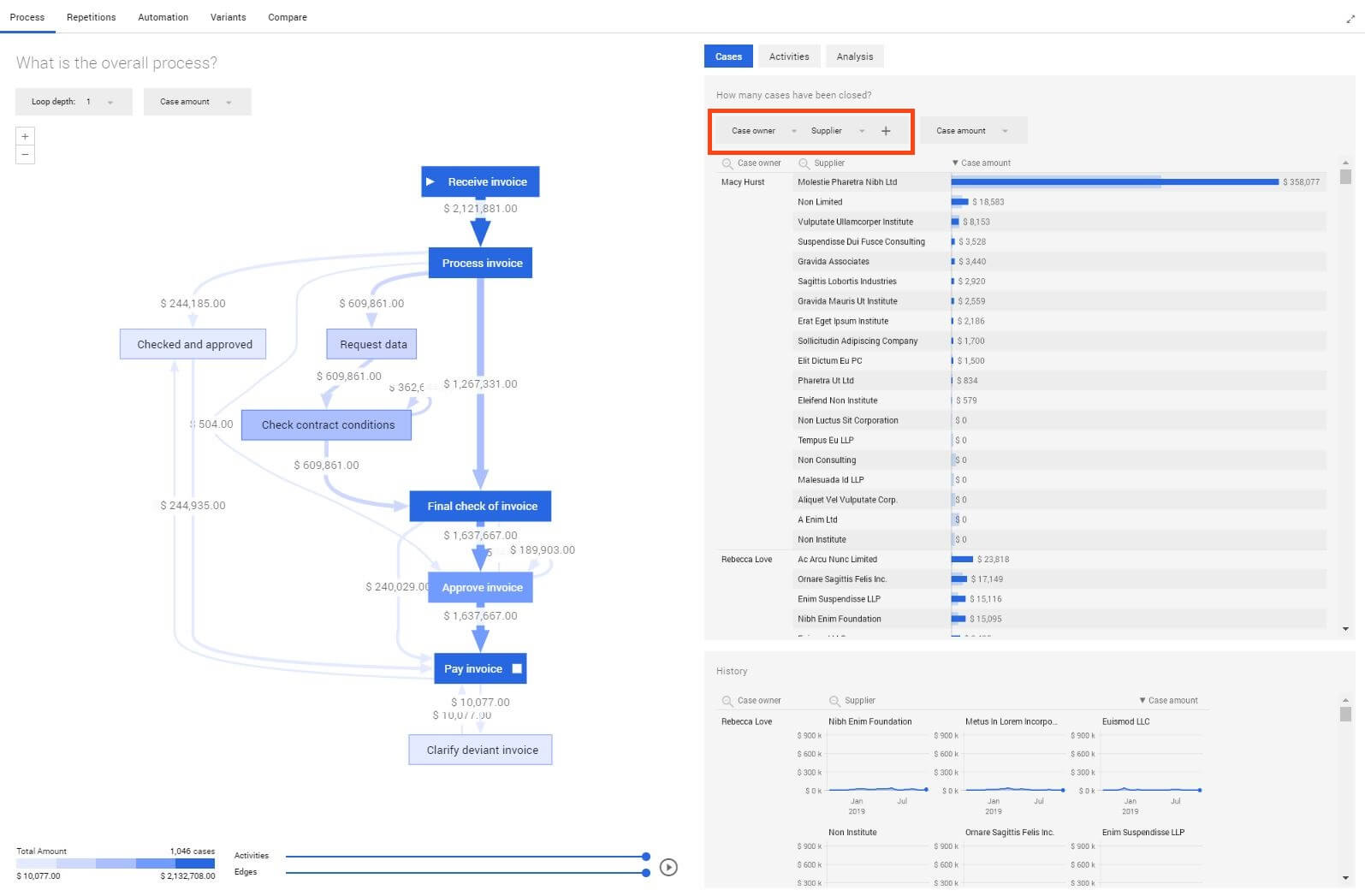
For example, an invoice processed during winter holidays might be delayed due to a high workload (specific for that season). Understanding what is behind the delay allows you to make more realistic data interpretations.
In general, you want to capture all variables that can influence the process. In another example, some of the suppliers of an organization used a standard invoicing application. By an invoicing application, we mean any software that speeds up the payment process for an organization.
The UiPath team showed the differences in a process flow before and after the use of such an application. The advantage of the invoicing app became immediately clear.
Discovering this with UiPath Process Mining saved a lot of time and resources from rework.
Implementing the invoicing app across various suppliers allowed the organization to get complete digital information on the invoice. This resulted in faster time to payment, less manual work, and a more streamlined procure-to-pay process.
2. Process flow agreements
Every process owner (a director or an executive) has an idea of how their process should flow. A process owner might outline this idea in an explicit guideline, containing a list of “do’s and don’ts” for a team to perform. It also can be an overview of departments assigned to certain steps within a process. All this is to describe a perfect scenario of a process – in process mining the perfect scenario is called “the reference model.”
The reference model is the powerful base for conformance checking – one of the most important steps of process analysis. Conformance checking lets a business analyst look at the actual process (the result of process mining) and compare it to the reference model. This way you can see where your team performs not as expected and take action to get closer to your ideal process (the reference model).
Thus, sometimes the findings from process mining don’t have to be complex to give business value. It’s enough to know who performed a certain process step, how they performed the step, and evaluate actual performance compared to expectations.
3. Timing agreements
After the process flow, timing is one of the most discussed topics during process mining projects.
Every process owner wants to run the most efficient process, without cutting corners. But what is an efficient process and how can you identify an efficient process in a process graph?
Efficiency is the quality of produced work in relation to the effort (time or resources). A process that is not delivering work on time is inefficient.
To effectively analyze what parts of your process take more time than they should, you need an estimate of how long every step of a process takes. Then, you can compare the time it takes to complete each step to the project timing expectations. UiPath Process Mining makes it easy to make those comparisons, detect bottlenecks, discover where you have resource shortages, identify external dependencies that slow down the process, and more.
If you want to dive deeper, see the terms of service-level agreements (SLAs). While working with one UiPath Process Mining customer recently, the process graph showed that for an accounts payable process the team paid invoices on time and met deadlines. Looking back at the related SLA, it appeared that if the team delivered the invoices two days earlier, our customer would receive a 20% discount and thus save a big payment to suppliers.
Such cases are not rare – paying too late or too early can have negative effects on your cash.
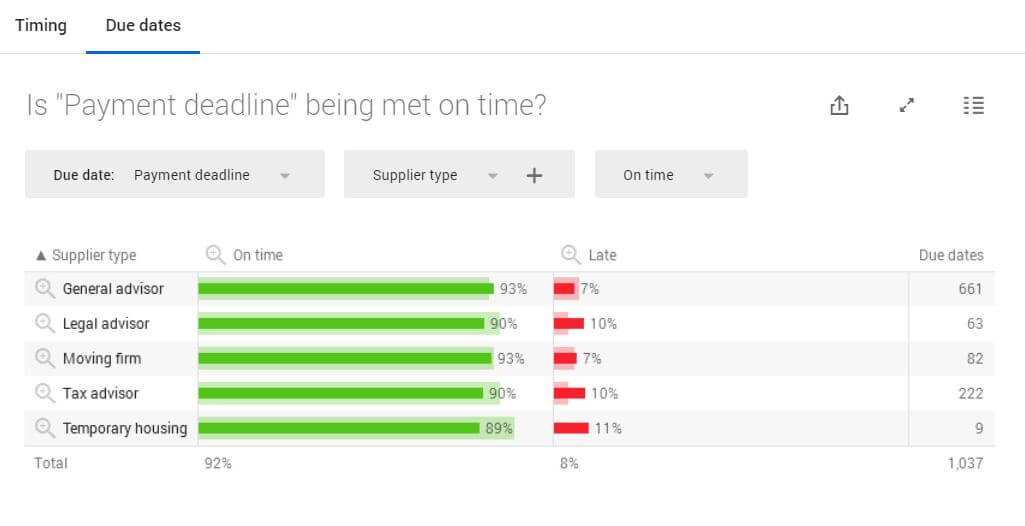
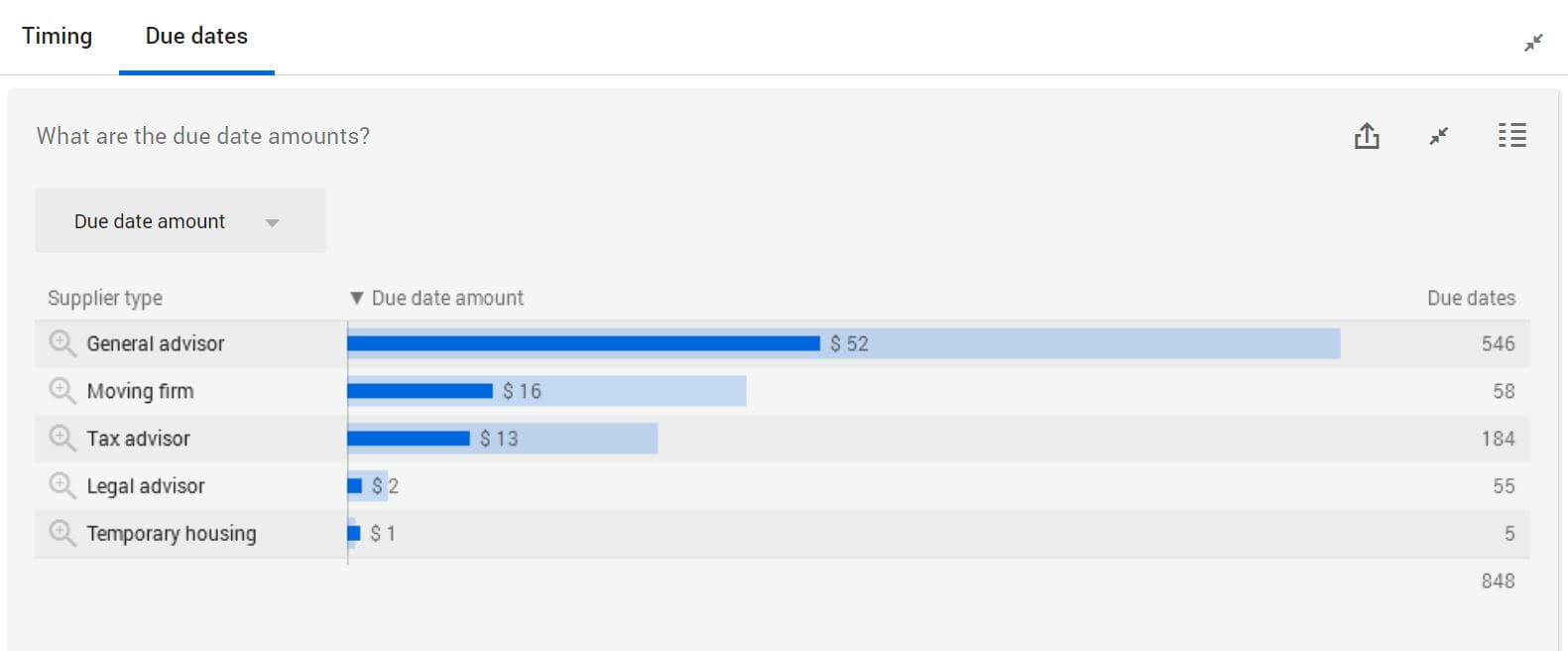
Another common example is SLAs for ticketing systems. Ticketing systems ease customer support services. Such systems allow support teams to communicate with customers in one place, track the customer’s history, KPIs on quality of support service, time to respond, and others.
Almost every help desk has SLAs around support tasks such as first response time and solution time.
When you identify the cause of not meeting SLAs, you can speed up the service (for example, by redesigning the team's work or automating the chat). Automation will help your team solve more issues and focus on problems requiring more attention and human logic. Altogether, these measurements can significantly improve your customer satisfaction rate.
4. User-based information
The most curious findings in process mining come from looking at how people work together. Especially when there are several teams, departments, facilities, or countries involved in one process. You’ve likely experienced this too – sometimes teams tend to shift responsibility from one to another.
Shifting responsibility not only decreases employee happiness but also causes delays in process execution, which can result in decreased productivity, financial losses, and decreased customer satisfaction.
UiPath Process Mining can give you a transparent view of how everyone involved in entire process are working together. You can see if the performance is matching your expectations and identify process steps that flow through different teams. If there is too much back-and-forth, you will see it in the User Interactions tab in the UiPath Process Mining tool.
Some activities like invoice payment are straight forward, while invoice approval requires a lot of interaction with other teams (see the image below). Over communication can slow down the end result.
Interactions for the invoice payment:
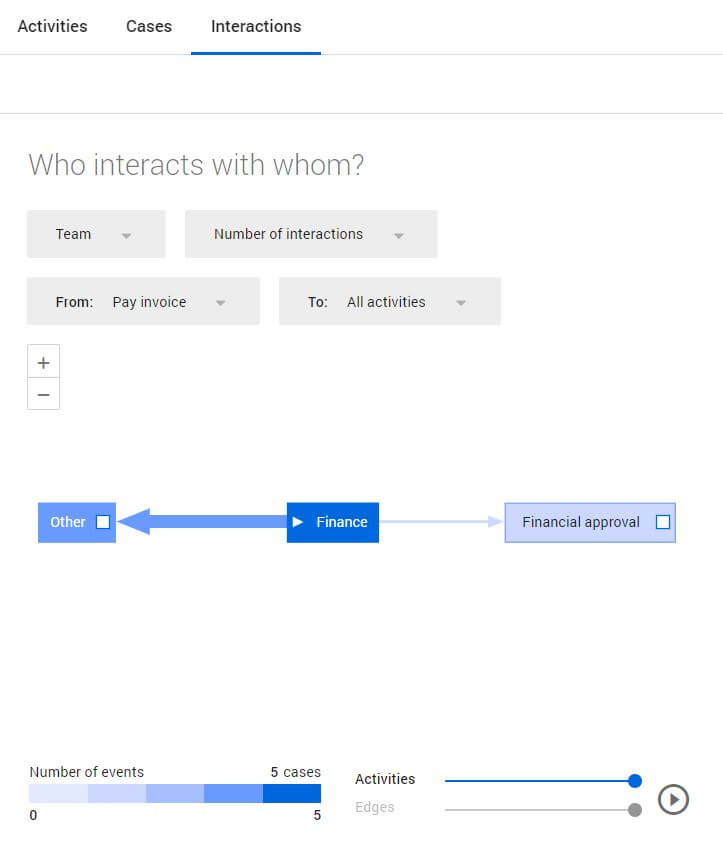
Interactions for the invoice approval:
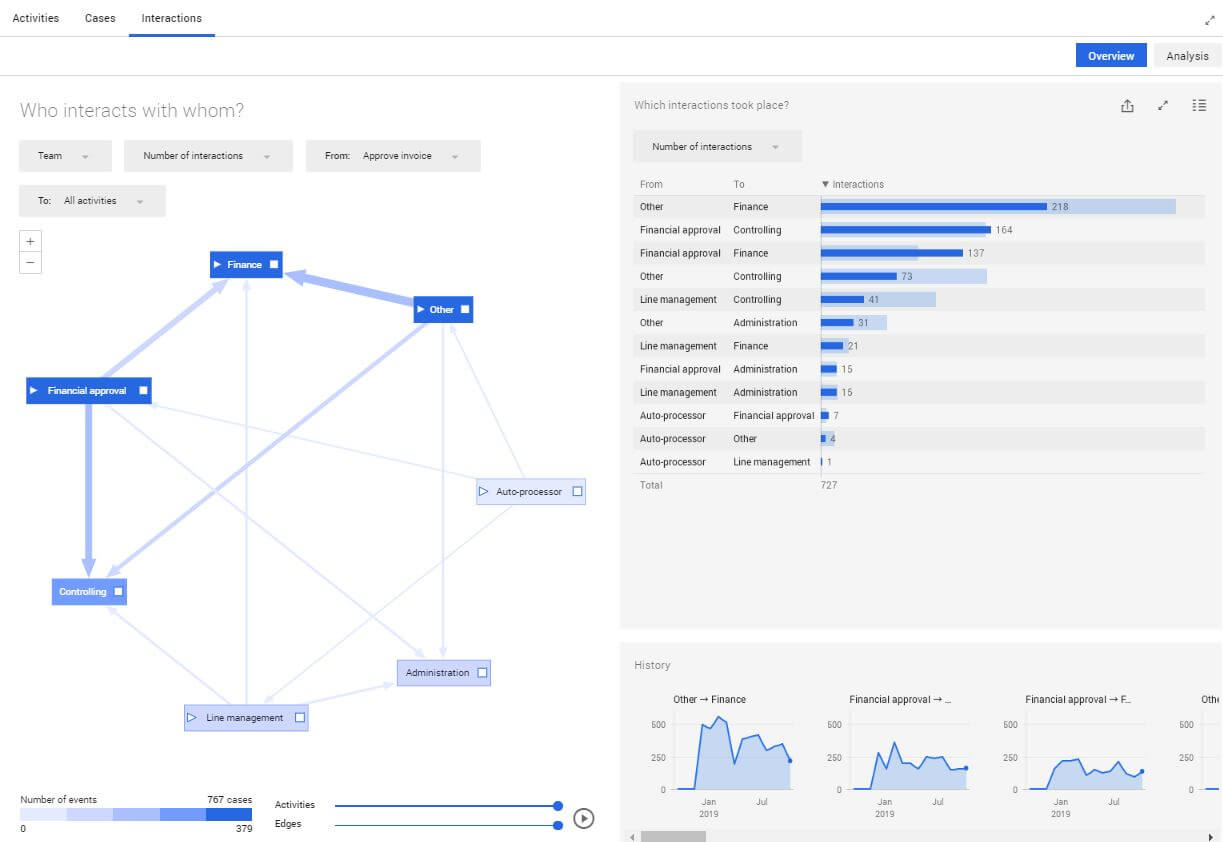
By spotting such process deviations, you can give more information to the teams on work division and the process team structure.
5. Monitoring your progress
Many organizations start process mining because of the process understanding and analytics capabilities.
Yet, discovering a process is not enough, the gained insights should be supported by strategic actions. You may want to automate your process to cut errors, speed up completion, and increase employees’ happiness by setting them free from mundane tasks. Or, you might optimize the process by adding resources, further training the staff, or taking a different tactic or strategy.
After changing your process in any way, use UiPath Process Mining to track how these changes affect your process performance.
Has there been an improvement?
Are you closer to your reference model?
Is your team meeting the key performance indicators (KPIs) or is there a need for extra actions?
By tracking changes and their influence on your process, you can determine the return on investment (ROI) for your process mining project. After a successful process analysis, the next item on your list is to plan process improvement and measure process performance.
What is an efficient process for you – is it improvement in speed or in quality?
Can automation help you speed up the process?
How many software robots would one process need?
What KPIs help you measure operational efficiency?
What evaluation method will you choose for regular checkups?
By answering all those questions and aligning the end-to-end process optimization strategy with UiPath, you’ll get closer to a continuous improvement cycle and self-sustainability. Get control of your processes, rethink the allocation of your resources, and boost business growth.
Remember, discovering a process is only the beginning of your journey to successful business process management. The real difference comes with the changes you put in place and actions you take to prevent risks, improve productivity, meet and exceed customer expectations, further optimize your growth strategy.
As process mining creates awareness of what’s going on in your organization, Robotic Process Automation (RPA) allows you to turn this awareness into action. Explore how process mining helps enterprises set the automation strategy for business growth in our recent white paper:
As we say at UiPath: “Your organization is ready for process mining when it’s ready for big changes.”
Happy mining!

EPS Solution Engineer, UiPath
Get articles from automation experts in your inbox
SubscribeGet articles from automation experts in your inbox
Sign up today and we'll email you the newest articles every week.
Thank you for subscribing!
Thank you for subscribing! Each week, we'll send the best automation blog posts straight to your inbox.



